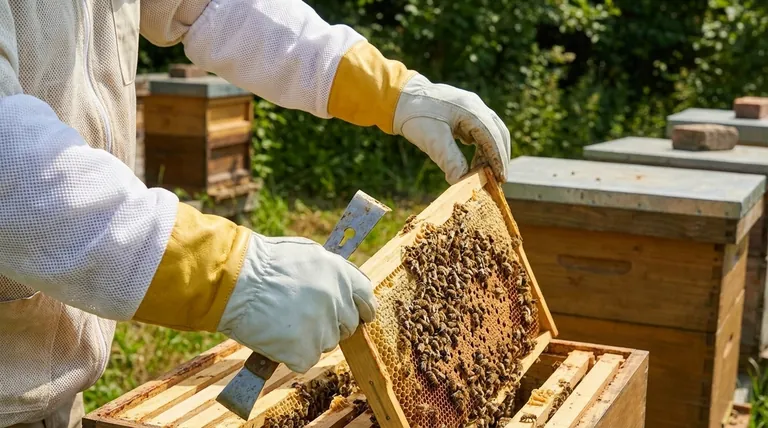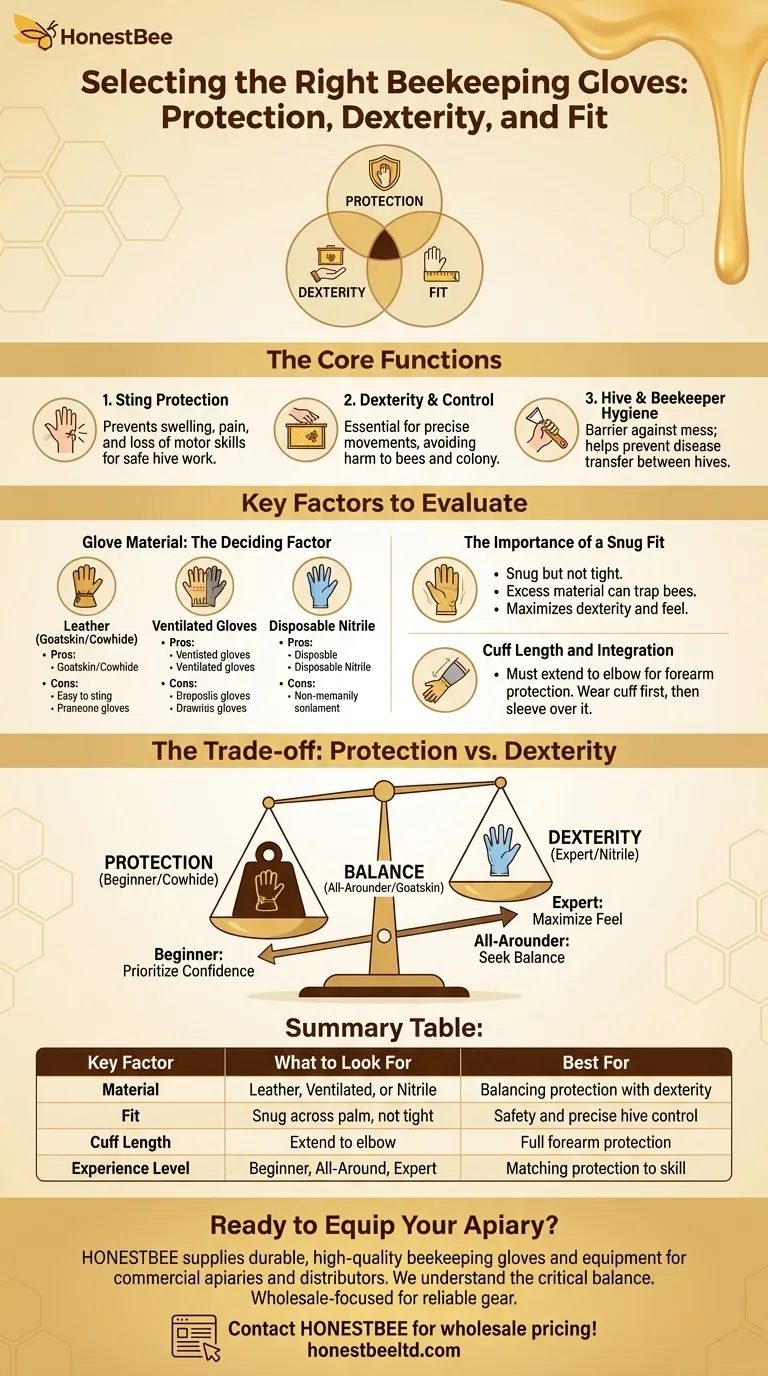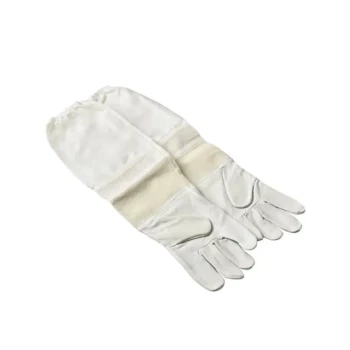Ultimately, your choice of beekeeping gloves comes down to balancing three critical factors: protection from stings, the dexterity needed to work gently, and a proper fit. The material of the glove largely determines the balance between protection and dexterity, while a snug fit is non-negotiable for both safety and effective hive management.
The central challenge in selecting beekeeping gloves is navigating the inherent trade-off between sting protection and manual dexterity. Your goal is not to find the single "best" glove, but to find the right material and fit that matches your experience level and comfort with your bees.

The Core Functions of Beekeeping Gloves
Before evaluating specific types, it's crucial to understand what the gloves are meant to accomplish. While the primary purpose is obvious, the secondary functions are just as important for good beekeeping.
Prioritizing Sting Protection
The most fundamental role of beekeeping gloves is to protect your hands and arms from stings. Bee stings on the hands can cause significant swelling, pain, and a temporary loss of fine motor skills, making it difficult to continue working in the hive safely.
Maintaining Dexterity and Control
Effective beekeeping requires gentle, precise movements. You must be able to lift frames without crushing bees, inspect delicate comb, and handle tools with confidence. Clumsy gloves can lead to accidental harm to the colony, which in turn can provoke a defensive reaction.
Ensuring Hive and Beekeeper Hygiene
Gloves provide a valuable barrier that keeps your hands clean from sticky honey and propolis. More importantly, they play a role in biosecurity by helping to prevent the transfer of potential bee diseases between different hives.
Key Factors to Evaluate
As you compare options, focus on how each glove performs in these three areas.
Glove Material: The Deciding Factor
The material dictates the balance between protection and feel.
- Leather (Goatskin or Cowhide): This is the most common material. Goatskin is prized for being relatively thin and supple, offering a good compromise between protection and dexterity. Cowhide is thicker and more durable, providing maximum protection but at the cost of being more cumbersome.
- Ventilated Gloves: Many leather gloves incorporate mesh or ventilated fabric along the cuffs. This significantly improves comfort and breathability during hot weather without compromising protection on the hands.
- Disposable Nitrile: Some experienced beekeepers opt for thin, disposable nitrile gloves. These offer maximum dexterity and feel but provide very little protection against a determined sting. They are primarily for hygiene and grip.
The Importance of a Snug Fit
A proper fit is essential for both safety and control. The gloves should be snug across your palm and fingers but not tight.
Excess material in a loose-fitting glove can get caught on hive parts or, worse, accidentally crush bees. A snug fit maximizes your dexterity, allowing you to feel what you are doing.
Cuff Length and Integration
Beekeeping gloves must have long cuffs that extend to your elbow. This ensures your forearms are protected when you reach deep into a hive box.
For maximum security, the glove's cuff should be worn first, with the sleeve of your bee suit or jacket pulled down over it. This creates a seal that bees cannot crawl through.
Understanding the Trade-offs: Protection vs. Dexterity
Your personal comfort level and experience will guide your choice along this spectrum.
For the Beginner: Prioritizing Confidence
If you are new to beekeeping, feeling secure is paramount. Starting with a thicker leather glove, like cowhide, provides the highest level of sting protection. This builds confidence and allows you to learn the craft without the fear and distraction of frequent stings.
For the All-Arounder: Seeking Balance
Goatskin leather gloves are the industry standard for a reason. They offer reliable sting protection for most situations while being flexible enough to allow for reasonably delicate work. Most beekeepers find this to be the ideal balance for routine inspections.
For the Expert: Maximizing Feel
As beekeepers become more experienced, their movements become more deliberate and gentle, and they learn to read the bees' temperament. Many then transition to thinner gloves, or even nitrile, to gain the dexterity needed for more advanced tasks like queen rearing, sacrificing sting-proof security for ultimate control.
Making the Right Choice for Your Goal
Evaluate your own needs to select the glove that best supports your beekeeping journey.
- If you are a new beekeeper or prioritize confidence: Choose a thicker leather glove, like cowhide, for maximum sting protection as you learn.
- If you need a reliable, all-purpose glove for routine inspections: Opt for a well-fitted goatskin leather glove to get the best balance of protection and dexterity.
- If your primary focus is maximum dexterity for delicate tasks: Consider thin nitrile gloves, but fully understand that you are trading significant sting protection for control.
Ultimately, the right gloves are the ones that allow you to work calmly and confidently, ensuring the safety and well-being of both you and your bees.
Summary Table:
| Key Factor | What to Look For | Best For |
|---|---|---|
| Material | Leather (Goatskin/Cowhide), Ventilated, or Nitrile | Balancing protection with dexterity |
| Fit | Snug across palm and fingers, not tight | Safety and precise hive control |
| Cuff Length | Long cuffs that extend to the elbow | Full forearm protection and secure seal |
| Experience Level | Beginner (Cowhide), All-Arounder (Goatskin), Expert (Nitrile) | Matching protection to your skill and comfort |
Ready to Equip Your Apiary with the Right Gloves?
Protection and precision are non-negotiable in beekeeping. HONESTBEE supplies durable, high-quality beekeeping gloves and equipment tailored for the needs of commercial apiaries and beekeeping equipment distributors.
We understand the critical balance between sting protection and the dexterity required for gentle hive management. Our wholesale-focused operations ensure you get the reliable gear your business depends on.
Let's discuss your needs and find the perfect solution for your operation.
Contact HONESTBEE today for wholesale pricing and expert advice!
Visual Guide

Related Products
- Beekeeping Gloves Goatskin Leather with Long Cotton Sleeve for Beekeepers
- Goatskin Leather Beekeeper Gloves with Vent Long Sleeve for Beekeeping Honey Bee Sting Proof Protection
- Mesh Ventilated 3 Layer Goatskin Beekeepers Gloves for Beekeeping
- Goat Skin Leather Bee Sting Proof Beekeeping Gloves with Canvas Sleeve
- Professional Galvanized Hive Strap with Secure Locking Buckle for Beekeeping
People Also Ask
- What is the difference between cleaning cow leather and goat leather beekeeping gloves? Tailor Your Care for Longevity
- What are the features of ventilated bee gloves? Stay Cool & Dexterous in Warm Weather
- What is the safest way to handle frames in beekeeping? Master Gentle Handling for a Calm Hive
- Why is dexterity and flexibility important in beekeeping gloves? Boost Your Hive Management Efficiency
- What should beekeepers consider regarding the fit of beekeeping gloves? Achieve Safety and Dexterity



















